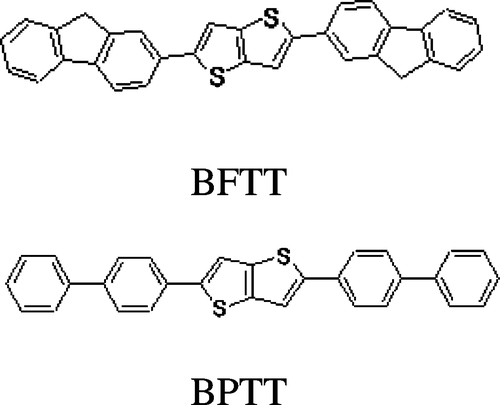Organic field effect transistors based on biphenyl, fluorene end-capped fused bithiophene oligomers
- 저자
- Yong-Young Noh , Reiko Azumi, Midori Goto, Byung-Jun Jung, Eunhee Lim, Hong-Ku Shim*, Yuji Yoshida, Kiyoshi Yase*, and Dong-Yu Kim*
- 저널명
- Chemistry of Materials, 17, 15, 3861–3870 (2005)
- 년도
- 2005
- Link
- https://doi.org/10.1021/cm0504889 288회 연결
[Abstract]
Organic field effect transistors based on a structural combination of fused bithiophene with fluorene(BFTT) or biphenyl units (BPTT) are described. The two molecules have similar molecular structures,except that the fluorene unit of BFTT is substituted for a biphenyl in BPTT. A 1.5-2 times higher fieldeffect mobility was achieved with BPTT compared to that of BFTT. To determine the reason for thesuperior mobility of BPTT compared to that of BFTT, single-crystal X-ray structures of BPTT and BFTTwere determined and a clear correlation between the crystal structure and the electrical characteristicswas found. The BFTT based on a fluorene unit adopts a slightly more distorted conformation that deviatesfrom the quasi-planar structure in the single crystal with larger dihedral and bending angles than thoseof BPTT. On the other hand, BPTT shows a quite planar structure with relatively small dihedral andbending angles. BFTT also shows longer shortest intermolecular distances than BPTT. Those are theresults of the carbon at the 9 position of fluorene units and attached hydrogen atoms on that position inBFTT, which is regarded as the only difference of the two molecules. These differences in molecularconformation and packing characteristics in the single-crystal consequently affect the transport propertiesof the electric carrier. In addition, device stability was checked after storage in air for more than 1 monthor after exposure to strong UV irradiation for several hours. Both molecules showed a high device stability,but BPTT was slightly better. This better air and UV stability of biphenyl-based BPTT, compared tofluorene-based BFTT, can be attributed to the lower highest occupied molecular orbital energy level ofthe BPTT and keto-defect formation in the fluorene unit of BFTT, after UV irradiation.
